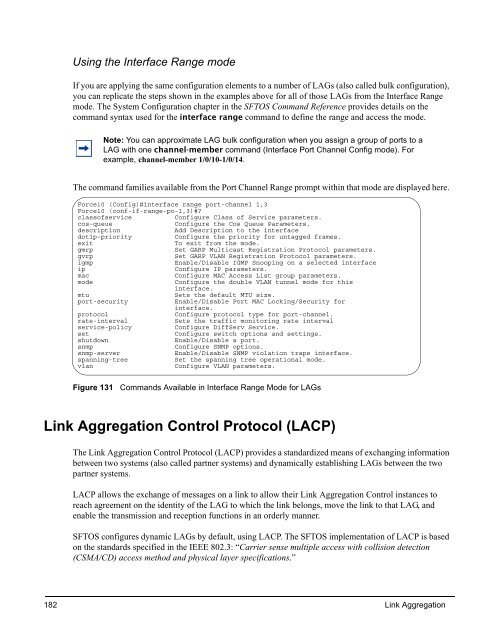Create successful ePaper yourself
Turn your PDF publications into a flip-book with our unique Google optimized e-Paper software.
Using the Interface Range mode<br />
If you are applying the same configuration elements to a number of LAGs (also called bulk configuration),<br />
you can replicate the steps shown in the examples above for all of those LAGs from the Interface Range<br />
mode. The System Configuration chapter in the SFTOS Command Reference provides details on the<br />
command syntax used for the interface range command to define the range and access the mode.<br />
Note: You can approximate LAG bulk configuration when you assign a group of ports to a<br />
LAG with one channel-member command (Interface Port Channel Config mode). For<br />
example, channel-member 1/0/10-1/0/14.<br />
The command families available from the Port Channel Range prompt within that mode are displayed here.<br />
<strong>Force10</strong> (Config)#interface range port-channel 1,3<br />
<strong>Force10</strong> (conf-if-range-po-1,3)#?<br />
classofservice Configure Class of Service parameters.<br />
cos-queue Configure the Cos Queue Parameters.<br />
description Add Description to the interface<br />
dot1p-priority Configure the priority for untagged frames.<br />
exit To exit from the mode.<br />
gmrp Set GARP Multicast Registration Protocol parameters.<br />
gvrp Set GARP VLAN Registration Protocol parameters.<br />
igmp Enable/Disable IGMP Snooping on a selected interface<br />
ip Configure IP parameters.<br />
mac Configure MAC Access List group parameters.<br />
mode Configure the double VLAN tunnel mode for this<br />
interface.<br />
mtu Sets the default MTU size.<br />
port-security Enable/Disable Port MAC Locking/Security for<br />
interface.<br />
protocol Configure protocol type for port-channel.<br />
rate-interval Sets the traffic monitoring rate interval<br />
service-policy Configure DiffServ Service.<br />
set Configure switch options and settings.<br />
shutdown Enable/Disable a port.<br />
snmp Configure SNMP options.<br />
snmp-server Enable/Disable SNMP violation traps interface.<br />
spanning-tree Set the spanning tree operational mode.<br />
vlan Configure VLAN parameters.<br />
Figure 131 Commands Available in Interface Range Mode for LAGs<br />
Link Aggregation Control Protocol (LACP)<br />
The Link Aggregation Control Protocol (LACP) provides a standardized means of exchanging information<br />
between two systems (also called partner systems) and dynamically establishing LAGs between the two<br />
partner systems.<br />
LACP allows the exchange of messages on a link to allow their Link Aggregation Control instances to<br />
reach agreement on the identity of the LAG to which the link belongs, move the link to that LAG, and<br />
enable the transmission and reception functions in an orderly manner.<br />
SFTOS configures dynamic LAGs by default, using LACP. The SFTOS implementation of LACP is based<br />
on the standards specified in the IEEE 802.3: “Carrier sense multiple access with collision detection<br />
(CSMA/CD) access method and physical layer specifications.”<br />
182 Link Aggregation
















